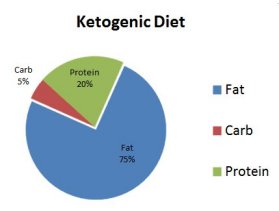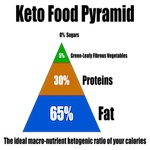It’s the end of another year and once again it’s time for me to start another crazy diet! Two years ago I followed a strict paleo diet for 6 months, which involved the elimination of all starch, dairy and nuts. Last year was my vegan challenge that eliminated all animal products for 6 months. This year I will be embarking on a 4 to 6 month extremely controlled ketogenic diet. As I had planned on following a ketogenic diet 4 months ago, I’m starting my ketogenic challenge a little late. But as the saying goes, better late than never!
The ketogenic diet is essentially a 70 to 80% fat based diet, consisting mostly of high fat nuts, unrefined fats and organic dairy. Based on my individual ketogenic state, I plan to have moderate vegetable intake while minimizing the consumption of animal protein. I would prefer to keep my protein intake lower, as I do not believe that excessive animal protein consumption is healthy. Further, I’m looking to model this diet and my experience with this diet, into a support strategy for my clients battling or interested in preventing cancer. I have a strong belief that animal protein consumption and sugar consumption can lead to cancer, so it will be important for me to limit the consumption of animal protein in my experimental diet.
The ketogenic diet is really very similar to the dietary beliefs that I have had for years. We need to reduce our starchy carbohydrate, refined sugar and excess fruit intake! In fact we need to reduce our caloric intake … period! This diet strategy just takes it to a new level and added to my challenge will be that I want to limit my animal protein intake at the same time!
Most of my clients have asked me why I do these extreme challenges, and I suppose the main reason is for the pursuit of knowledge and in support of my amazing clients that follow these dietary strategies! It’s one thing to know about a specific diet but its an entirely different thing for that diet to become a way of life for people. Plain and simple, diets scare people but they are the most powerful tool we have in controlling our health, second to physical exercise! In this particular case, I believe that a modified ketogenic diet can reduce the incidence, if not slow or arrest the growth of cancer and the science to support this statement is being made available at an alarming pace. I also think this diet is a major answer to increasing life expectancy, when done properly and in conjunction with calorie restriction.
The Basic Concepts
http://www.ketogenic-diet-resource.com/ketogenic-diet-plan.html
There are many low carbohydrate, ketogenic diet plans from which to choose and they all involve following a higher fat, moderate protein, low carb food plan.
The main difference between a regular low carb diet plan and a ketogenic diet plan is the amount of carbohydrate and protein allowed on a daily basis:
 A ketogenic diet plan requires tracking the carb amounts in the foods eaten and keeping carbohydrate intake between 20-50 grams per day. The daily protein requirement will be moderate, and depends on height, gender and how much exercise is done. The balance of calories will be from fats. These ratios ensure that most people go into ketosis and stay there, which is the main objective of the ketogenic diet.
A ketogenic diet plan requires tracking the carb amounts in the foods eaten and keeping carbohydrate intake between 20-50 grams per day. The daily protein requirement will be moderate, and depends on height, gender and how much exercise is done. The balance of calories will be from fats. These ratios ensure that most people go into ketosis and stay there, which is the main objective of the ketogenic diet.- The nutrient intake on a ketogenic diet typically works out to about 70-75% of calories from fat, 20-25% from protein, and 5-10% from carbohydrate on a daily basis. Since a ketogenic diet reduces hunger, most find they don’t really need to get involved in calorie counting, unless one feels more comfortable tracking them.
The key to understanding a ketogenic diet plan is to remember that one is swapping out the carbs in the diet with a higher fat and a moderate protein intake.
Exert from Ketogenic Diets: A Key to Excellent Health
Ketogenic diets are those in which fats provide most of the calories. Carbohydrates (sugars and starches) are severely limited, and protein intake is moderate. The term ketogenic refers to the fact that when the body metabolizes fat for fuel, ketone bodies are created through ketogenesis. Ketone bodies are fragments of fatty acids created when your liver and kidney cells metabolize fats. Your cells can use ketones for fuel, and if fat burning is increased, it results in ketosis, which is an elevated level of ketones in the bloodstream.
Ketogenic diets are powerful, metabolically speaking. Switching to a high-fat, low-carbohydrates ketogenic diet can eliminate heartburn, improve cardiac risk factors and reverse the elevated blood pressure, high blood sugar, and dyslipidemia associated with metabolic syndrome.
In addition, other research has shown that the metabolic effects of eating more fats and less carbohydrates can alleviate many serious health issues. Medical researchers and some physicians are using ketogenic diets to reduce the tremors of Parkinson’s disease and help Alzheimer’s patients regain memory and thought function, drive various cancers into remission, give diabetics better control over their blood sugar and lipid profiles, and improve epilepsy treatment outcomes.
How can a simple diet have so much power? The secret is in the effect that eating ketogenically has on blood sugar, insulin, and ultimately, cellular energy processes.
Glycation is a process in which excess blood sugar sticks to and damages the proteins of body tissues. These injured proteins stop functioning correctly, and this results in a chain of events that increases inflammation and creates substances called advanced glycation end-products (AGEs). Advanced glycation end-products interfere with cellular function, and are linked to the progression of many disease processes, including Alzheimer’s, cardiovascular disease, stroke, and autism.
Eating a steady diet of foods that drive up your blood sugar increases glycation damage and inflammation, because the extent of glycation damage is directly linked to glucose and insulin concentrations in the bloodstream.
The higher the blood sugar, the more serious the damage. Glycation damage is why diabetics with chronically high blood sugar experience neuropathy, higher rates of cancer and heart disease, kidney damage, and blindness. You want to minimize glycation damage and the resulting inflammation as much as possible for good health.
An overview of the ketogenic diet for pediatric epilepsy.
Nutr Clin Pract. 2008 Dec-2009 Jan;23(6):589-96.
Epilepsy is the most common serious neurological condition in the world, with an estimated prevalence of 1% of the population. The highest incidence occurs in childhood and in the elderly, with lower levels in early adulthood. Traditional epilepsy management includes pharmacological treatment, epilepsy surgery, and vagal nerve stimulation. Despite these therapies, 25% of children continue to have uncontrolled seizures. The ketogenic diet (KD), which has been in use since 1921, is a treatment option for many of these children. A meta-analysis of 19 studies with a combined sample of 1084 pediatric patients was completed in 1998 by Blue Cross Blue Shield. Estimates of the overall efficacy of the KD in controlling seizures were reported as follows: 16% became seizure free, 32% had a >90% reduction in seizures, and 56% had a >50% reduction. The KD is high in fat, moderate in protein, and low in carbohydrates. This combination of energy results in a sustained ketosis that somehow serves to abate seizures through an unknown mechanism. Strict adherence to the diet is required for it to be effective. Newer, more liberal versions of the KDs have been recently introduced and are being studied in children and adults. Administration of all of these metabolically adjusted diets must be medically managed as there can be adverse effects. The focus of this review is on the pediatric application of the KD.
